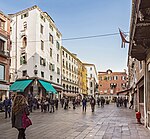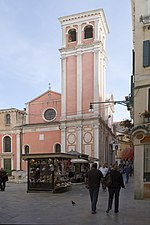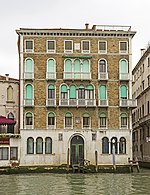San Lio, Venice
18th-century Roman Catholic church buildings in Italy9th-century establishments in ItalyBaroque architecture in VeniceRoman Catholic churches completed in 1783Roman Catholic churches in Venice

San Lio is a church located on the campo of the same name in the sestiere of Castello.
Excerpt from the Wikipedia article San Lio, Venice (License: CC BY-SA 3.0, Authors, Images).San Lio, Venice
Salizada San Lio, Venice Venezia-Murano-Burano
Geographical coordinates (GPS) Address External links Nearby Places Show on map
Geographical coordinates (GPS)
| Latitude | Longitude |
|---|---|
| N 45.4375 ° | E 12.338611111111 ° |
Address
Chiesa di San Lio
Salizada San Lio
30120 Venice, Venezia-Murano-Burano
Veneto, Italy
Open on Google Maps











